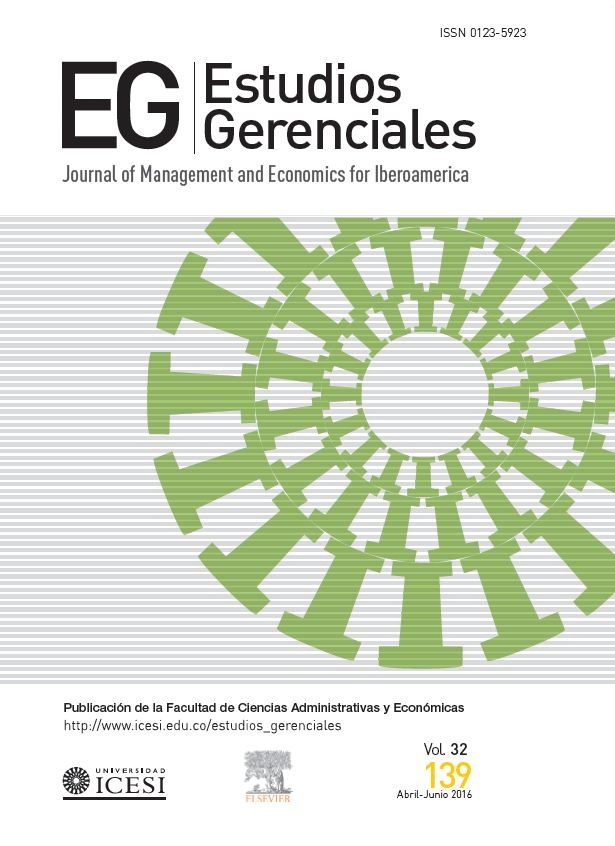El capital social y la planificación adaptativa en una comunidad industrial innovadora del Perú
DOI:
https://doi.org/10.1016/j.estger.2016.05.001Keywords:
Innovación, Planificación adaptativa, Innovación social, Capital socialAbstract
El presente estudio vincula el capital social y la planificación adaptativa con la innovación y el desarrollo empresarial de una comunidad de productores vitivinícolas en el Perú. Dado lo anterior, se considera que tanto el capital social como la planificación adaptativa impactan en el aprendizaje productivo y el desarrollo de valores empresariales en ciertos escenarios donde predomina un extendido conocimiento tácito tradicional y colectivo –perdurable a través de siglos– y que se transforma en innovación. La metodología utilizada para la validación empírica fue el análisis factorial exploratorio, a través del cual se confirmó la propuesta teórica.Downloads
References
Ahuja, G. (2000). The duality of collaboration: inducements and opportunities in the formation of interfirm linkages. Strategic Management Journal, 21(3), 317–343.
Bagozzi, R. P. y Yi, Y. (1988). On the evaluation of structural equation models. Journal of Marketing Science, 16(1), 74–94.
Balmes, J. (2009). El Criterio. Barcelona: Araluce.
Bossan, B., Jann, O. y Hammerstein, P. (2015). The evolution of social learning and its economic consequences. Journal of Economic Behavior & Organization, (112), 266–288.
Cabrera, J. M. (2008). Diez motivos para innovar. Mediterraneo Económico, (17), 11–28.
Cazorla, A., de los Rios, I. y Salvo, M. (2007). Desarrollo rural: Modelos de planificación. Madrid: Mundi-Prensa.
Coleman, J. (1990). Foundations of social theory. Cambridge MA: Belknap Press.
Covin, J. G. y Slevin, D. P. (1989). Strategic management of small firms in hostile and benign environments. Strategic Management Journal, 10(1), 75–87.
Doz, Y. L. y Hamel, G. (1998). Alliance advantage: the art of creating value through partnering. Boston: Harvard Business Press.
Dyer, J. H. y Hatch, N. W. (2006). Relation-specific capabilities and barriers to knowledge transfers: creating advantage through network relationships. Strategic Management Journal, 27(8), 701–719.
Dyer, J. H. y Singh, H. (1998). The relational view: cooperative strategy and sources of interorganizational competitive advantage. Academy of Management Review, 23(4), 660–679.
Friedmann, J. (1973). Retracking America: a theory of transactive planning. New York: Double and Anchor Books.
Goodall, K. y Roberts, J. (2003). Only connect: teamwork in the multinational. Journal of World Business, 38(2), 150–164.
Grootaert, C. (1998). Social capital: the missing link? Social Capital Initiative [consultado 10 Abr 2016]. Disponible en: http://siteresources.worldbank.org/INTSOCIALCAPITAL/Resources/Social-Capital-Initiative-Working-Paper-Series/SCI-WPS-03.pdf
Gulati, R. (1998). Alliances and networks. Strategic Management Journal, 19(4), 293–317.
Guns, B. (1998). Faster learning. Executive Excellence, (September), 7–8.
Hair, J. F., Anderson, R. E., Tatham, R. L. y Black, W. C. (2004). Análisis multivariante. Madrid: Pearson -Prentice Hall.
Jansen, J. J., van den Bosch, F. A. y Volberda, H. W. (2005). Managing potential and realized absortive capacity: how do organizational antecedents matter? Academy of Management Journal, 48(5), 999–1015.
Lam, A. (2003). Organizational learning in multinationals: R&D Networks of japanese and US MNEs in the UK. Journal of Management Studies, (40), 673–703.
Lumpkin, G. T. y Dess, G. G. (1996). Clarifying the entrepreneurial orientation construct and linking it to performance. Academy of Management Review, 21(1), 135–172.
Lundvall, B. A. (2007). National innovation systems - analytical concept and development tool. Industry and Innovation, 14(1), 95–119.
Nahapiet, J. y Ghoshal, S. (1998). Social capital, intellectual capital, and the organizational advantage. Academy of Management Review, 23(2), 242–266.
Programa de las Naciones Unidas para el Desarrollo-PNUD. (2005). Desarrollo humano: hagamos de la competitividad una oportunidad para todos. Informe. [consultado 10 Abr 2016]. Disponible en: http://bvs.minsa.gob.pe/local/MINSA/1344 PNUD-IDH2005-1.pdf
Putnam, R. (2003). El declive del capital social: un estudio internacional sobre las sociedades y el sentido comunitario. Barcelona: Galaxia Gutenberg.
Rauch, A., Wiklund, J., Lumpkin, G. T. y Frese, M. (2009). Entrepreneurial orientation and business performance: an assessment of past research and suggestions for the future. Entrepreneurship Theory and Practice, 33(3), 761–787.
Román, R. E., Gómez, A. y Smida, A. (2013). El capital social organizacional de la pequeña empresa innovadora. Un ensayo de medición en las ciudades de Cali y Medellín. Estudios Gerenciales, 29(128), 356–367.
Vegas, J.C. (2008). Asociatividad. [consultado 10 Abr 2016]. Disponible en: http://www.mincetur.gob.pe/comercio/ueperu/consultora/docs_taller/Presentaciones_Tumbes_y_Piura/1.2.1.2.F1_Asociatividad_20080912.pdf Wang, C. L. (2008). Entrepreneurial orientation, learning orientation and firm performance. Entrepreneurship Theory and Practice, 32(4), 635–657.
Zaheer, A. y McEvily, B. (1999). Bridging ties: a source of firm heterogeneity in competitive capabilities. Strategic Management Journal, 20(12), 1133–1156.
Downloads
Published
Issue
Section
License
Articles are the sole responsibility of their authors, and will not compromise Icesi’s University principles or policies nor those of the Editorial Board of the journal Estudios Gerenciales. Authors authorize and accept the transfer of all rights to the journal, both for its print and electronic publication. After an article is published, it may be reproduced without previous permission of the author or the journal but the author(s), year, title, volume, number and range of pages of the publication must be mentioned. In addition, Estudios Gerenciales must be mentioned as the source (please, refrain from using Revista Estudios Gerenciales).








